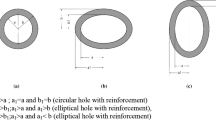Abstract
Tensile experiments were performed for open-hole composite plates with three different layups. With the limited number of experimental results, a probabilistic neural network (PNN) based approach is proposed to predict the tensile strength of composite plates with an open-hole. The predictive model takes the geometric parameters, the layup features and the average tensile stress of open-hole composite plates as the inputs and produces the safety status as the intermediate output with the classification function of PNN. Then the critical safety point, that is the open-hole tensile strength, where the safety status turns from survival to failure, is determined with the bi-section searching method. The predictions produce acceptable results whose errors are comparable to the coefficient of variation of experimental results. With experimental data from other studies, further assessments are also made to prove the capability of this model in predicting the open-hole tensile strength of composite plates.







Similar content being viewed by others
References
Waddoups, M.E., Eisenmann, J., Kaminski, B.E.: Macroscopic fracture mechanics of advanced composite materials. J. Compos. Mater. 5(4), 446–454 (1971)
Beaumont, P.: The failure of fibre composites: an overview. J. Strain Anal. Eng. 24(4), 189–205 (1989)
Puck, A., Schürmann, H.: Failure analysis of FRP laminates by means of physically based phenomenological models. Compos. Sci. Technol. 58(7), 1045–1067 (1998)
Whitney, J., Nuismer, R.: Stress fracture criteria for laminated composites containing stress concentrations. J. Compos. Mater. 8(3), 253–265 (1974)
Backlund, J., Aronsson, C.G.: Tensile fracture of laminates with holes. J. Compos. Mater. 20(3), 259–286 (1986)
Tan, S.: Laminated composites containing an elliptical opening. I. Approximate stress analyses and fracture models. J. Compos. Mater. 21(10), 925–948 (1987)
Nguyen, B.N.: Three-dimensional modeling of damage in laminated composites containing a central hole. J. Compos. Mater. 31(17), 1672–1693 (1997)
Morais, A.B..: Open-hole tensile strength of quasi-isotropic laminates. Compos. Sci. Technol. 60(10), 1997–2004 (2000)
Maa, R.H., Cheng, J.H.: A CDM-based failure model for predicting strength of notched composite laminates. Compos. B Eng. 33(6), 479–489 (2002)
Green, B., Wisnom, M., Hallett, S.: An experimental investigation into the tensile strength scaling of notched composites. Compos. A Appl. Sci. 38(3), 867–878 (2007)
Ghezzo, F., Giannini, G., Cesari, F., Caligiana, G.: Numerical and experimental analysis of the interaction between two notches in carbon fibre laminates. Compos. Sci. Technol. 68(3), 1057–1072 (2008)
O’Higgins, R., McCarthy, M., McCarthy, C.: Comparison of open hole tension characteristics of high strength glass and carbon fibre-reinforced composite materials. Compos. Sci. Technol. 6(13), 2770–2778 (2008)
Flatscher, T., Wolfahrt, M., Pinter, G., Pettermann, H.: Simulations and experiments of open hole tension tests—assessment of intra-ply plasticity, damage, and localization. Compos. Sci. Technol. 72(10), 1090–1095 (2012)
Pidaparti, R., Palakal, M.: Material model for composites using neural networks. AIAA J. 31(8), 1533–1535 (1993)
Labossiere, P., Turkkan, N.: Failure prediction of fibre-reinforced materials with neural networks. J. Reinf. Plast. Compos. 12(12), 1270–1280 (1993)
Lee, C., Hwang, W., Park, H., Han, K.: Failure of carbon/epoxy composite tubes under combined axial and torsional loading 1. Experimental results and prediction of biaxial strength by the use of neural networks. Compos. Sci. Technol. 59(12), 1779–1788 (1999)
Lee, J., Almond, D., Harris, B.: The use of neural networks for the prediction of fatigue lives of composite materials. Compos. A Appl. Sci. 30(10), 1159–1169 (1999)
Velten, K., Reinicke, R., Friedrich, K.: Wear volume prediction with artificial neural networks. Tribol. Int. 33(10), 731–736 (2000)
Al-Assaf, Y., El Kadi, H.: Fatigue life prediction of unidirectional glass fiber/epoxy composite laminae using neural networks. Compos. Struct. 53(1), 65–71 (2001)
Zhang, Z., Friedrich, K., Velten, K.: Prediction on tribological properties of short fibre composites using artificial neural networks. Wear 252(7), 668–675 (2002)
Zhang, Z., Friedrich, K.: Artificial neural networks applied to polymer composites: a review. Compos. Sci. Technol. 63(14), 2029–2044 (2003)
Kadi, H.E.: Modeling the mechanical behavior of fiber-reinforced polymeric composite materials using artificial neural networks—a review. Compos. Struct. 73(1), 1–23 (2006)
Perera, R., Barchin, M., Arteaga, A., Diego, A.D.: Prediction of the ultimate strength of reinforced concrete beams FRP-strengthened in shear using neural networks. Compos. B Eng. 41(4), 287–298 (2010)
Camara, E.C.B., Freire, R.C.S.: Using neural networks to modeling the transverse elasticity modulus of unidirectional composites. Compos. B Eng. 42(7), 2024–2029 (2011)
Bashir, R., Ashour, A.: Neural network modelling for shear strength of concrete members reinforced with FRP bars. Compos. B Eng. 43(8), 3198–3207 (2012)
Varol, T., Canakci, A., Ozsahin, S.: Artificial neural network modeling to effect of reinforcement properties on the physical and mechanical properties of Al2024-B4C composites produced by powder metallurgy. Compos. B Eng. 54, 224–233 (2013)
Specht, D.F.: Probabilistic neural networks. Neural Netw. 3(1), 109–118 (1990)
Specht, D.F.: Enhancements to probabilistic neural networks. In: Proceedings of the IEEE International Joint Conference on, Neural Networks, pp. 761–768 (1992)
Noor, A.K., Starnes, J.H., Peters, J.M.: Uncertainty analysis of composite structures. Comput. Methods Appl. Mech. 185(2), 413–432 (2000)
Manan, A., Cooper, J.: Design of composite wings including uncertainties: a probabilistic approach. J. Aircr. 46(2), 601–607 (2009)
Sriramula, S., Chryssanthopoulos, M.K.: Quantification of uncertainty modelling in stochastic analysis of FRP composites. Compos. A Appl. Sci. 40(11), 1673–1684 (2009)
Parzen, E.: On estimation of a probability density function and mode. Ann. Math. Stat. 33(3), 1065–1076 (1962)
Tan, S.C.: Laminated composites containing an elliptical opening. II Experiment and model verification. J. Compos. Mater. 21(10), 949–968 (1987)
Afaghi-Khatibi, A., Ye, L., Mai, Y.: An effective crack growth for residual strength evaluation of composite laminates with circular holes. J. Compos. Mater. 30(2), 142–163 (1996)
Author information
Authors and Affiliations
Corresponding author
Rights and permissions
About this article
Cite this article
Fan, HT., Wang, H. Predicting the Open-Hole Tensile Strength of Composite Plates Based on Probabilistic Neural Network. Appl Compos Mater 21, 827–840 (2014). https://doi.org/10.1007/s10443-014-9387-2
Received:
Accepted:
Published:
Issue Date:
DOI: https://doi.org/10.1007/s10443-014-9387-2




